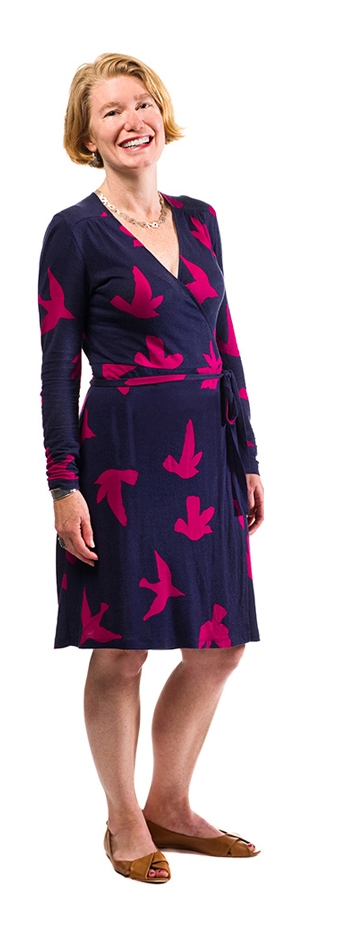
By Joni B. Cole
This Focus on Faculty Q&A is one in a ongoing series of interviews exploring what keeps Dartmouth professors busy inside—and outside—the classroom.
For Amy Gladfelter, an associate professor of biological sciences, an understanding of the dynamics of life can be found at the end of a polarized light microscope. Gladfelter is fascinated by single cells with many nuclei. How do they organize in time and space? How do they grow and divide? Gladfelter shares her thoughts on cell gazing, running a small business, and how a passion for dance made her a better scientist.
When you’re looking through that microscope, what exactly are you looking for?
We can engineer the living cells to express a fluorescent protein, so we can follow the localization and dynamics of individual proteins. But the real challenge is to pull it all together, which cells do every moment of every day. That’s one of our passions: to understand how, out of a complex mixture of billions of proteins and molecules, you get spatially organized behavior within a cell. It’s like a packed New York subway car in there, yet most of the time it works.
Any recent “awe” moments in the lab?
A pretty recent one happened about two-and-a-half years ago. We made an artificial plasma cell membrane and put it on a glass slide, and we added this purified protein in the hopes that we could start to understand how a particular polymer—a septin—forms in the cell. All of a sudden these gorgeous filaments started forming under the microscope. We realized that we had an assay now to study the fundamental properties of these proteins. This whole world opened up.
And why does it matter how these proteins work?
They’re absolutely critical for learning and memory. They also seem to be important in the development of cancer, and are actually being used as cancer markers. But we didn’t really understand how they work normally. That’s my true reason to get up in the morning: We have to understand the fundamentals of life to understand what goes wrong when there is a disease process.
Did you always want to be a scientist?
I had a very idyllic rural Florida childhood, footloose and fancy-free. I did love the natural world and spent a lot of time outside, collecting stuff and looking at it under this little microscope. But for a long time, I thought I was going to be a professional dancer. Then I spent a summer in a lab after my freshman year in college and it totally turned me on.
Tell me about your dance life.
I did ballet intensively. I did modern, tap, African. Even as a postdoc I was dancing and performing. Finally, when I was here, pregnant with my second child, I was like, all right, I can’t do this anymore.
What drew you to dance?
Same thing as with science. You lose yourself. You don’t think about anything else. You’re just moving and listening to music. It’s like meditating, but you’re moving.
You have your own lab and you teach? How is your time divided?
When I’m teaching a full course, it could easily be half and half. When I’m not teaching, I’m doing lab and science work, and writing papers and grants, and that part is never over. But on some level I could say I spend 100 percent of my time teaching because I’m always training people—undergrads, grad students, postdocs—how to think like scientists, how to do science. And it’s not facts; it’s a “how would you approach this problem?” kind of teaching. It’s very one-on-one.
The funding climate right now makes getting an NIH grant harder than ever. What kind of pressure does that put on you?
Each research lab at Dartmouth is really a small business managed by the scientist and supported mostly by the federal government. Salaries, equipment, anything I need—it’s all from my grants. So if you can’t get grants and you start having to fire someone and lose expertise, or you can’t get that piece of equipment, the lab can unravel very quickly.
Sexism in the sciences—does it still exist?
I don’t think there is overt bias or intended bias against women, but once you reach the established level, I look around and realize there are not a lot of women. We’re training many, many women at the undergrad and PhD level, and to a certain degree at the postdoc level, but then they’re gone. So where do they go? I think many of them leave because of the culture of science—a culture based on criticism, where aggressive personalities often rise to the top, and where many women are not as innately comfortable. So it’s lack of confidence sometimes that makes women decide maybe I’m not cut out for this. On the other hand, I think women bring to the table strengths that are critical. They’re often more team oriented and collaborative.
You have a son and daughter, 9 and 6. Did being a geneticist have any effect on you when you were pregnant?
Oh, yeah, totally. I was absolutely freaked out about all the things that could go wrong. I didn’t do extra testing, but I did all the testing that was available. And I was very cautious until they were born. I tended to not count my babies until they were hatched.
Given your job, when you look at people do you sometimes see them as a collection of cells?
It’s funny, earlier today I had to run out to my kids’ school to help with a nature walk. I definitely look at leaves and think about what’s going at the cellular level. I don’t so much with people, but I do with other parts of the natural world, for sure.
This interview has been edited and condensed.
